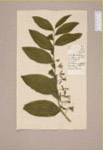When J.F. Oberlin arrived in Ban de la Roche, the most common remedy used for most ailments consisted of a mixture of olive oil and strong liquor. For the first few years of his ministry, J.F. Oberlin studied and indexed all of the local plant life so that he could then circulate his research. His herbarium consists of 45 bundles. Each bundle includes about 25 files in which the collected plants are grouped together by species, or group of species.
Linné’s classification system was used for the first 34 bundles. 3 bundles constitute a herbarium called “The Herbarium of Waldersbach”, in which the boards are organised into 3 classes:
Class 1: useful plants
Class 2: Order 1: unusual plants
Order 2: flowers
Class 3: Order 1: medicinal plants
Order 2: hazardous plants
Another bundle bears the words “Class 2: unusual flowers or plants”. The two bundles “Herbes du Pré St Jean” and “Herbes de Mon Verger”, 1781 are associated with the bundles of the “Herbier of Waldersbach”.

In one file marked “Unclassified Plants”, the samples are missing labels, and the last two files are called “Unknown Plants”. The names of the plants are indicated on the labels, and may be in Latin, French, German and Alsatian or in the provincial dialect. On certain boards J.F. Oberlin also added the Latin description of the genus and the species, the date of harvest, the location and a classification number. The samples are inserted into the labels. A few boards are completed by illustrations or comments indicating the difficulties encountered during determination. For medicinal plants, he used the classification system of R. Spielmann, with the plants classified according to their properties: nourishing, fortifying, softening or soothing, irritant, harmless – sleep inducing, subduing, cleansing and poisonous. He shared the results of his research by creating educational worksheets. These worksheets featured prints of the plants or engravings cut out of scientific publications.
The names in French, German, Latin and sometimes provincial dialect of the plants were indicated. The month of bloom was always shown in green, the scientific indications were in red and Linné’s references were in black. These worksheets were provided to teachers for their teaching requirements.These worksheets can be found on a few boards of the herbarium.



